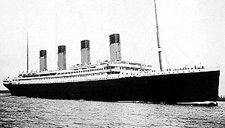It was dubbed the “unsinkable” ship. But as the rich and mighty banqueted and danced their way into the night on this largest passenger steamship in the world at that time, tragedy loomed in the form of an iceberg.
Four days into its maiden voyage 98 years ago, shortly before midnight on April 14, 1912, the ship struck the iceberg. Two hours and forty minutes later, at 2.20 a.m. local time on April 15, the “unsinkable” Titanic sank, leaving in its wake 1,517 deaths.
More than half of the 2,223 people on board were dead, making it one of the deadliest peacetime maritime disasters in history.
The Titanic began its voyage from Southampton, England, heading for New York on April 10, 1912, with Captain Edward J. Smith in command.
 |
| RMS Titanic departing from Southampton, for the first and only time, on April 10, 1912. Courtesy wikipedia |
Heeding the iceberg warnings received via wireless in the days preceding the disaster, Capt. Smith had drawn up a new course which took the ship slightly further southward. That fateful Sunday at 13:45, a message from the steamer Amerika once again warned that large icebergs lay in the Titanic's path, but wireless radio operators, unfortunately did not relay such "non-essential" ice messages to the bridge. Later that evening, another report of numerous large icebergs, this time from the Mesaba, also failed to reach the bridge.
At 23:40, Fred Fleet, who survived the tragedy, first sighted the iceberg one-fourth of a mile dead-ahead, from the crow's nest. Instinctively he sounded the ship's bell three times, shouting, “Iceberg right ahead!” Ironically, Fleet's words doomed the Titanic. The iceberg brushed the ship's starboard side near the bow. Six of her 16 watertight compartments were flooded and as the sea rose above the watertight bulkheads, adjoining compartments flooded like sections of an ice-cube tray. Yet, the Titanic stayed afloat more than an hour longer than most experts on board predicted.
Although several ships responded to the desperate signals sent out by the wireless operators on board the Titanic, none was close enough to make it in time. The closest ship to respond, Carpathia, was 93 km away, and could arrive in an estimated four hours -- too late to rescue all of the Titanic's passengers. However, according to records SS Californian, may have been closer but had not responded to the distress reports.
Many of the passengers and crew abandoned ship or were swept away when the vessel briefly upended in the water, but settled back at an angle. All 20 lifeboats and rafts, fewer than half the number needed, were launched, pulling away from the ship for safety which action doomed most survivors afloat, for the temperature of the sea was 280F (-20C). Shortly afterwards, the stress on the hull caused the Titanic to break apart between the last two funnels and the bow went under. The stern righted itself slightly and then rose vertically. After a few moments, at 2. 20, this too sank. The Carpathia which arrived in the area at 4.10 began rescue operations, picking up the survivors on the last lifeboat by 8.30 and heading for New York by 8.50.
Only 706 survived the disaster, with a majority of the others perishing due to hypothermia in the freezing water, with death coming in less than 15 minutes.
While all children in first and second class were saved, two thirds of children in third class perished.
Many are the stories about dogs which were on the Titanic. Apparently, a passenger released the dogs just before the ship went down and they were seen running up and down the decks, with at least two escaping a watery death.
One of the most famous stories of the Titanic is of the band. On April 15, the eight-member band, led by Wallace Hartley, assembled in the first-class lounge in an effort to keep passengers calm and upbeat. Later they moved on to the forward half of the boat deck. The band continued playing, even when it became apparent that the ship would sink and all members perished.
A water-stain on the dial of a watch recovered from the floating body of a victim on April 23, a week after the disaster, indicates that the hour hand stopped just short of two o’clock.
Sources : * How We Found Titanic. The National Geographic Magazine, VOL. 168, NO. 6, December 1985 and * www.encyclopedia-titania.org
|
